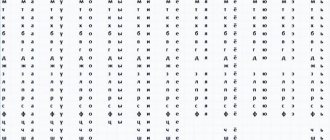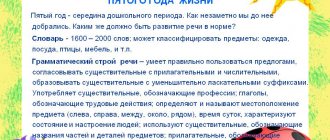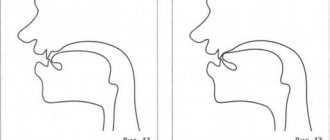The sound "Ш", its profile and description.
A longitudinal channel is formed along the midline of the tongue, through which a stream of exhaled air passes. The soft palate is raised (Ш - oral sound). The vocal folds are open (Ш – dull sound).
Lower articulation
The tip of the tongue is lowered, slightly pulled away from the lower incisors, the middle part of the back of the tongue is raised as much as possible. The lateral edges are pressed against the upper molars. The lower Shch differs from the lower Sh in that the tongue occupies a more forward position, and the middle part of the back of the tongue is raised higher.
Sound pronunciation disorders.
Types of hissing sigmatism
They are the same as those of whistlers (with the exception of the hissing pronunciation of whistlers), but they are also added:
- buccal pronunciation of sibilants. The tongue does not take part in pronunciation; the exhaled stream encounters an obstacle in the form of close teeth and the corners of the mouth pressed against them. This produces a dull noise;
- back-lingual pronunciation of sibilants. The gap is formed by the convergence of the back of the tongue with the hard palate. The result is a sound reminiscent of X or Ukrainian G.
Parasigmatism of the sibilants
If the sounds Sh, Zh, Shch, Ch are replaced by other sounds, then such a violation is called parasigmatism of sibilants. Sound substitutions are a phonemic defect, i.e. this indicates imperfection of phonemic perception, which is very important to take into account when correcting.
The sound Ш is most often replaced by S, T, Ж, Ш, Х, З.
The sound Ж is most often replaced by Z, Ш, С, Д.
The sound Ш is most often replaced by Сь, Ш, Т, Ш, СТ, ШЧ.
The sound Ch is most often replaced by Ш, Ть, С, Ц.
Staging methods.
1. By imitation:
- the child is offered a sample of sound pronunciation in combination with play images (a small snake hisses, etc.); At the same time, visual control of correct articulation and tactile (tactile) sensations are used.
2. From the articulatory structure:
— the child is asked to reproduce the articulatory pattern of sound, apply the correct air stream, and determine the presence/absence of a voice; the result should be a normalized sound.
3. From reference sound:
- the child is asked to pronounce the sound ch - chschschsch for a long time...
4. From reference sound with mechanical assistance:
- the child is asked to pronounce the syllables si/as, using a spatula to slightly lift the tip of the tongue towards the alveoli, gently pushing it back, the result should be the sound sch.
Articulation gymnastics.
Standard pronunciation of sound
[Ш']
sound profile [Ш']
Correct sound style.
Upper articulation
The lips are pushed forward, there is a small gap between the incisors, the tip of the tongue is raised towards the alveoli, forming a gap with them. The front part of the tongue is more advanced compared to W. The lateral edges of the tongue are pressed against the upper molars. The middle part of the back of the tongue is raised towards the hard palate, the back part of the back, compared to W, is more advanced.
Staging sound in various ways.
1. By imitation:
- the child is offered a sample of sound pronunciation in combination with play images (a small snake hisses, etc.); At the same time, visual control of correct articulation and tactile (tactile) sensations are used.
2. From the articulatory structure:
— the child is asked to reproduce the articulatory pattern of sound, apply the correct air stream, and determine the presence/absence of a voice; the result should be a normalized sound.
3. From reference sound:
— the child is asked to pronounce the sound Ch – Ch Shch Shch for a long time...
4. From reference sound with mechanical assistance:
- the child is asked to pronounce the syllables SI - AС, using a spatula to slightly lift the tip of the tongue towards the alveoli, gently pushing it back, the result should be the sound Shch.
Correction of violations of the pronunciation of the sound Ш
The child is asked to pronounce a long sound Ш, at this time the speech therapist moves the corners of the lips, producing the sound Ш.
[H]
Disadvantages in the pronunciation of hissing sounds (Ш, Ж, Ш, Ш) are called sigmatism. (Distortions are called sigmatism, replacements are called parasigmatism).
Types of sigmatism:
1. Interdental sigmatism.
2. Labiodental sigmatism.
3. Dental sigmatism.
4. Hissing sigmatism..
5. Lateral sigmatism occurs in two forms:
1) the vocal-exhalatory stream passes through one or both passages between the lateral teeth and the edges of the tongue, the tip of the tongue is raised upward;
2) the back of the tongue with a hump tightly touches the palate, and the exhalation current passes along one or both sides of the mouth near the molars.
6. Nasal sigmatism.
Parasigmatism of hissing sounds manifests itself in the following main substitutions: Ch – Sh.
When setting the affricate H, the speech therapist suggests that the speech pathologist pronounce the syllable AT and at this time, placing a spatula or probe under the front edge of the tongue, lifts it to the alveoli of the upper incisors. At the same time, the speech therapist lightly presses his fingers on the corners of the mouth, pushing the lips forward. With this position of the tongue and lips, instead of the syllable AT one hears ACH, instead of OT - OC, instead of UT - UC, etc. As the speech therapist consolidates this sound in his kinesthetic and auditory representation, he begins to pronounce it independently (without mechanical assistance ) in backward and forward syllables, and then in words and phrases. In addition, oral and written exercises are needed to differentiate this sound from the sounds S and Ts.
[R]
Disadvantages of pronunciation of sounds Р, Рь
called
rhotacism,
replacing the sounds
P, Pb - pararotacism.
Types of rotacism
1. Labial-labial, or “coachman” pronunciation, in which the lips vibrate as in onomatopoeia .
2. Single-impact pronunciation. In this case, there is no vibration of the tip of the tongue, the tip of the tongue hits only once on the alveoli of the upper incisors.
3. Lateral pronunciation. With this type of pronunciation, a distinction is made between bilateral and unilateral lateral rhoticism. With unilateral pronunciation, the tip of the tongue deviates to the right or left (right-sided or left-sided lateral rotacism). With bilateral lateral rotacism, the lateral edges of the tongue vibrate.
4. Burry or throaty pronunciation. There are two subtypes of it: velar P, which is formed by vibration of the soft palate, and uvular, in which a small uvula vibrates.
5. Nasal pronunciation, when the sound R has a nasal, nasal connotation, as the air stream passes through the nose.
The sound P is most often replaced by the following sounds: l, l', ј, d, g, v.
In most cases, to obtain correct articulation of the sound P, preparatory exercises are necessary, which can be roughly divided into two types.
One type of exercise is aimed at achieving the correct position of the tongue, obtaining the so-called fricative P, articulated in the same position of the tongue as the normal one, but so far without vibration.
Another type of exercise is aimed at developing tongue vibration. If the child correctly pronounces the upper Sh and Zh, it is not difficult to obtain the fricative P. It is enough to invite him to pronounce the phoneme Z in a drawn-out manner with his mouth slightly open without rounding his lips and move the front edge of the tongue a little forward, to the gums of the upper incisors. Having achieved the goal, you should fix the fricative P on the material of syllables, words, and then phrases, without waiting for the vibration to be absorbed. It is important that the resulting sound is pronounced with sufficient pressure of exhaled air, with a minimum gap between the front edge of the tongue and the gums. Not only the voice, but also the sound of air passing through the gap should be clearly audible.
To generate vibration, one should proceed from the rapid repetition of the sound D on one exhalation, articulated in a special way - with the mouth slightly open and when the front edge of the tongue is closed not with the incisors, but somewhat deeper - with the gums of the upper incisors or even with the alveoli.
The exercise may initially consist of two or three even repetitions of the sound d (dd, dd, dd... ddd, ddd, ddd...), then of the same repetitions, but with the last sound being strengthened (dd dD dD, ddd, ddd, ddd... ) and further from repeated repetition of the sound d, both uniformly (dddddddd...), and with rhythmic emphasis, for example, on every third sound of the series (ddD, ddD, ddD, ddD). Only the tongue should work when the lower jaw is stationary.
Subsequently, the two- or three-fold repetition of the sound d ends with the pronunciation of a vowel, a or s (dda, dda, dda... ddy, ddy, ddy... ddd, ddd, ddd... ddd...).
Another technique for generating vibration is to place a probe with a ball at the end under the tongue during a long pronunciation of the fricative P. The ball is brought into contact with the lower surface of the tongue, after which rapid movements of the probe to the right and left cause mechanical vibration of the tongue, alternately closing and opening its anterior edge with the alveoli. Instead of a probe, the child’s finger can be successfully used, first washed or wiped with a cotton swab soaked in alcohol. Initially, finger movement is carried out passively, with the help of a speech therapist who holds the child’s hand. In the future, the child acts independently.
After vibration has been achieved, it is necessary, through various exercises on the material of syllables, words and phrases pronounced at a gradually accelerating pace, to achieve automation of the learned articulation and get rid of the excessively booming pronunciation of R, inevitable in the early stages of work. If at first you only get hard P, then simultaneously with fixing it, you need to start working on soft P'. If at first you get a soft P', then in parallel with fixing it, you should start working on the hard P'.
[L]
Disadvantages of pronunciation of the sounds L, L are called lambdacism, replacement of the sounds L, L - paralambdacism.
Types of lambdacism:
1. Labial pronunciation, reminiscent of the sound u. In this case, the sound is pronounced with the participation of the lips, the tip of the tongue is lowered, lying on the bottom of the oral cavity.
2. Labial-dental pronunciation, reminiscent of the sound v. The lower lip approaches the upper teeth, the tip of the tongue lies at the bottom of the mouth.
3. Interdental pronunciation. With this type of lambdacism, the tip of the tongue is between the teeth.
4. Softened pronunciation, average between hard and soft pronunciation. In this case, the sound L is pronounced with a more raised middle part of the back of the tongue.
5. Nasal pronunciation. With this type of lambdacism, the soft palate is lowered, the root of the tongue rises to the soft palate, air goes into the nose, and a very unpleasant nasal sound is heard.
Paralambdacism includes all replacements of the hard or soft sound L with other sounds: v, y, r, d, y, n, l'.
The following techniques are used to correct lambdacism.
First, the child is given a task according to the proposed model, using a mirror, freely stick out his tongue and hold it between his teeth. Then he must, without changing the position of his tongue, pronounce A or Y protractedly. Now the speech therapist only formulates the instructions, and he himself articulates in front of the mirror without a voice. Even with this position of the speech organs, a drawn-out L can be obtained, which, however, should not be drawn to the child’s attention, so that he does not fall into the usual pronunciation.
The first exercises aimed at consolidating the resulting articulation are reduced to pronouncing the resulting sound in syllables with the vowel A: first in a closed syllable (AL), then between vowels (ALA) and, finally, in an open syllable (LA). Next, syllables with vowels Y, O, U are introduced (ala, aly, alo, alu, la, ly, lu, etc.).
In cases where lambdacism affects not only L, but also its soft pair - L, the correction of the first sound serves as a reliable basis for assimilating the second. The latter is usually easily achieved in open syllables with front vowels (LI, LE), and then with other vowels when comparing syllables including LIL' (la-la, lo-le, lu-lyu).
After the correct articulation of the sound L has been achieved and exercises have been done to consolidate it on the material of syllables, words and phrases, in cases of paralambdacism it is necessary to carry out a series of exercises aimed at developing the differentiation of the newly acquired sound and the one with which it was previously replaced.
[TO]
Disadvantages in the pronunciation of the sounds K and Kb are called kappacism.
Those types of defects that are associated with the replacement of these sounds with some others are called paracappacism.
There are three main types of kappacism.
The peculiarity of the first type is that instead of the sound k, a characteristic soft guttural click is heard. It occurs as a result of the fact that the vocal cords are tightly closed, the action of the respiratory muscles under them creates increased air pressure, after which the cord explodes and air noisily breaks through the glottis.
The second type includes paracappacism in the form of replacing the sound K with the sound G (“tapusta”, “reta”, “paut”).
In the third case, the plosive sound K is replaced by the fricative X (“khapusta”, “reha”, “pauh”), which again characterizes the defect as paracappacism.
An anomaly in the structure of the speech apparatus, which predisposes to the occurrence of cappacism, is the irregular shape of the hard palate, when it turns out to be too narrow and high, making it difficult to form a dense lingual-palatal stop.
AND
management of kappacism. If it is not possible to correct K on the basis of imitation with demonstration of articulation in front of a mirror, they resort to the mechanical method of setting K from K using a spatula. The child is encouraged to pronounce the syllables ta-ta-ta. Repeated pronunciation of the same syllables is preceded by pressing with a spatula on the front part of the back of the tongue and holding it behind the lower incisors. Under such conditions, instead of GO, GY is obtained. Next, the exercise is done with slightly deeper pressure on the tongue, as a result of which, instead of GA, you should get a KY. Finally, the spatula moves even deeper and pure K is obtained.
When carrying out exercises to consolidate the sound K in syllables and words, the speech therapist must ensure that before the front vowels (KE, KI) the closure of the tongue with the palate moves forward. Otherwise, the correct sound of these syllables in which hard K turns into soft Kb will not be obtained.
Having achieved the correct pronunciation of the sound K, you can then, without spending any additional effort, obtain its soft pair - Kb.
In cases where paracappacism, expressed in the replacement of the sound K with the sound X, is corrected, exercises on the material of syllables, words and phrases should be aimed at both consolidating the sound k and differentiating this sound with its previous substitute.
[G]
Disadvantages in the pronunciation of the sounds Г and Гь are called gammacism.
Those types of defects that are associated with the replacement of these sounds with some others are called paragammatism.
The disadvantages of pronunciation of the sound g are generally similar to the varieties of kappacism and hitism discussed above. In some cases, instead of g, a guttural click is heard, in others, the southern Russian g, which is a kind of voiced x, and thirdly, a guttural, voiced fricative sound, formed by the closeness and vibration of the vocal cords (Ukrainian sound g).
It is also found, more often in preschool children, para-gammacism in the form of replacing g with the sound d (“dusi”, “roda” instead of geese, horns).
If the child correctly pronounces the sound K (initially or as a result of correction of gammacism), then the first attempt to eliminate gammacism should consist of showing and explaining the difference in the Goth sound of its deaf pair. In this case, it is useful to put the child’s hand on the neck (above the larynx) and give him the opportunity to feel the vibration of the larynx and the movement of the anterior wall of the pharynx, which occurs under the pressure of the air accumulating in it before the air explodes.
You can take as analogues such pairs of syllables as afa-ava, asa-aza, asha-azha, ana-aba, ata-ada, and on this basis get the pair aka-aga. The child must pronounce these syllables after the speech therapist, controlling both himself and him the sonority of paired phonemes with the help of a hand attached to the neck.
If the described techniques do not lead to the goal, you should use a mechanical method of setting the sound G from D, similar to that indicated above for setting K from T. This time the syllable yes is successively converted into the syllable DY (first stage), then into GY ( second stage) and, finally, in GA (third stage).
The initial production of the G sound is followed by exercises on the material of syllables, words and phrases, which in the case of paragammatism, which is expressed in the replacement of the G sound with D, should be aimed at both consolidating the sound and distinguishing it from the previous substitute.
[X]
Disadvantages in the pronunciation of the sounds X and XL are called hitism.
Those types of defect that are associated with the replacement of these sounds with some others are called parachitism.
Disadvantages in the pronunciation of the sound x can manifest themselves either in a violation of its normal sound (chitism), or in replacing it with the sound k (parachitism). In the first case, a weakened guttural noise is usually heard, which occurs due to the fact that the exhaled air encounters a gap on its way, formed not by the tongue and palate, but by the close vocal folds. Instead of halva, mukha, mokh one hears then “halva”, “muha”, “moh”. Such formation x, quite normal for many languages (including Ukrainian), is unusual for the Russian language. In the second case, the tongue actively participates in articulation, but instead of a cleft it forms a stop with the palate.
Correction of hitism and parachitism.
In both cases, you should first of all try to get the correct pronunciation of X based on the sound K and accompanying the articulation with aspiration. The result should be a kind of lingual-posterior palatal affricate, something like KH. In the future, all that remains is to separate the fricative part of such a combination from the explosive part and consolidate the resulting articulation with an exercise.
If this technique does not lead to the goal, you should use another. It consists of placing the X from C in a mechanical manner similar to that by which the K from G is placed. The child is encouraged to pronounce the syllable SA, extending the consonant sound - СССА. Repeated playback of the same syllable is preceded by pressing with a spatula on the front of the back of the tongue and holding it behind the lower incisors. Under such conditions, instead of SA, we get something between SA and SHA. Further advancement of the spatula into the depths of the mouth leads to the transformation of the syllable SY into HY, and with even deeper pressure, HA is obtained.
[Y]
Lack of pronunciation of the sound И (j) is called iotacism.
Disadvantages in the pronunciation of the sound j (Y) are found mainly in preschoolers and usually consist of replacing it with the sound L' (“apple”, “monkey”, “tram” instead of apple, monkey, tram;
“lyozhik”, “ruzhle” instead of hedgehog, gun;
“lyubka”, “I play” instead of skirt, I play).
Correction of the deficiency in the simplest cases can be achieved by temporarily replacing the sound J (j) with the vowel I. The child is asked to pronounce combinations of vowels such as IA, AIA, IO, AI, OI, etc., slightly extending the phoneme i. The simplest words with ascending and descending diphthongs are also pronounced: ia - apple; io -yozhik; ai - play; oi - stop, etc. Next, more difficult words are introduced: maiak, laugh, play. Finally, the most difficult ones follow: monkey, piot, shiut, etc.
Gradually, the duration of the vowel shortens, and from a syllabic sound it turns into a non-syllabic one.
If the indicated technique does not lead to the goal, you can use the mechanical method of setting Y (j) from Z, similar to how X is placed from C, but with the difference that in this case the final stage is not the third, but the second stage of work. The child is encouraged to pronounce the syllable ZA (drawing out the consonant sound) and the spatula is pressed on the very front of the tongue, resulting in something between Z'A and Z'A. Then the spatula is moved a little deeper until a clear ja is heard.
Similarly, from the combination AZA we get aja.
Further, from the combinations ZO, ZU, ZE, AZO, AZU, AZE, the syllables jo (ё), jy (yu), jе (e), ayo, ayu, ae, etc. are obtained.
Consolidation
After the child has managed to pronounce the sound “sh”, it is important to consolidate the result and automate the process.
For this purpose, a special task file
for every baby.
You need to start with simple words and phrases
in which problematic sounds are often found.
You can also keep a special home notebook to consolidate
the results, where children, starting from
the 1st grade,
will be able to write down
texts
with abundant content of the letter “w”.
It is necessary that the child not only phonetically
correctly pronounced the sound “sh”, but also used it correctly in
grammar
. If the letter is written and used correctly, the baby will try to use it correctly in conversation.
In such a notebook, you need to give the task of adding endings in the words: Nata...(sha) pi...(shet), Timo...(sha) wants to eat...(sha), Ma...(sha) collects lands...(shi).
You need to teach your child to create a diminutive form of words: uncle - uncle, crumb - crumb, ear - ear, spot - spot.
Expert opinion
Margarita Sergeevna S.
Speech pathologist and speech pathologist with 15 years of experience working in various speech correction centers with children of different ages.
You should compose a text where the letter “w” appears constantly; words should be replaced with pictures. When reading, the child will try to pronounce the words correctly. It is important to maintain an entertaining component for the baby, then he will perceive the activities as a game.
There is a wide selection of poems
and
pure tongues
, which are aimed at establishing the sound “sh” in children.
Expert opinion
Margarita Sergeevna S.
Speech pathologist and speech pathologist with 15 years of experience working in various speech correction centers with children of different ages.
The child should also be able to correctly use the letter “w” in spelling. To do this, he needs to make sentences with problematic sounds. You can start with simple monosyllabic sentences, gradually complicating the task.
Hissing sounds and their correct pronunciation [sh], [zh], [sch] and [h]
Articulatory gymnastics for hissing sounds - exercises aimed at practicing the sounds [ w ], [ zh ], [ sch ] and [ h ].
When pronouncing the sound [ w ], the speech organs normally take the following position:
- lips are slightly pushed forward; the tip of the tongue is raised to the palate (to the alveoli), but does not touch it, forming a gap;
- the lateral edges of the tongue are pressed from the inside to the upper molars or hard palate, without allowing a stream of exhaled air to pass along the sides.
- Thus, the tongue takes the shape of a ladle or cup.
— the vocal cords are open, the stream of exhaled air passes freely between them;
-the air stream is exhaled evenly in the middle of the tongue, it is strong, wide, warm, and can be easily felt with the back of the hand brought to the mouth.
Any deviation from the correct articulation pattern leads to sound distortion. When staging a sound, our main task is to create the correct articulation of a given sound.
The articulation of the sound [ zh ] differs from the articulation of the sound [ w ] by the presence of a voice.
The articulation of the sounds [ ш ] and [ ч ] differs from the articulation of the sound [ ш ] by the additional rise of the middle part of the tongue towards the palate. In addition, the sound [ h ] is a closure-fissure sound, that is, when it is pronounced, the front part of the back of the tongue first closes with the alveoli, and then a gap is formed between them.
The following exercises contribute to the development of the necessary movements of the tongue and air stream.
Incorrect pronunciation of sounds
1) pronunciations: interdental, buccal, lateral
2) “lower” pronunciation of the sounds “ Ш” , “ Х” (a gap is formed between the front part of the back of the tongue and the hard palate, reminiscent of the sound “ Ш ”)
3) posterior lingual (the gap is formed by the convergence of the back of the tongue and the hard palate)
4) replacement with other hissing or whistling sounds











